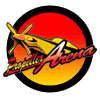




info:gamespot's preview
By Ricardo Torres, GameSpot [POSTED: 08/17/01 08:12 PM]
Since making its name with such arcade classics as Space Harrier, Outrun, and Afterburner, Sega developer AM2 has gone on to amass a varied and respected catalog of arcade and console games. Proving equally adept at creating games with addictive, accessible gameplay such as their classic arcade hits and more complex games such as the Virtua Fighter series and Shenmue, AM2 has managed to offer gamers an impressive amount of variety. Its latest original console game, Propeller Arena: Aviation Battle Championship for the Dreamcast, marks a return to its classic roots, serving up a dose of old-school arcade-style air combat with some modern twists.
Propeller Arena's basic premise is simple: Pick a mode, pick a plane, go to an arena, and blow up your three opponents as many times as you can. Lather, rinse, repeat. The game offers a total of four modes to zip around in, some of which offer some variations on the above theme. Championship puts you in a series of 10 battles, and in order to progress to the next battle, you must rack up enough kills to place in the top three at the end of each fight. Quick battle allows you to hop right into a duel in any of the available arenas. Power-ups ranging from air mines, homing missiles, speed bursts, or bombs that set off huge nuclear-style explosions can be used in the championship and quick battle modes. The power-ups are housed in colored crates that you must destroy in order to acquire them. The training area allows you to hone your piloting skills by offering timed runs through arenas that challenge you to perform specific aerial feats for points. Finally, the network mode allows you to go online and take on three other opponents.
Making use of real- time voice chat technology like the recently released Alien Front Online, Propeller Arena will ship with a Dreamcast microphone and allow you to chat (or talk smack) with your opponents during network battles. Online stat tracking will also keep tabs on your performance and allow you to see who might be worthy of taking you on. Another welcome technological perk will be the game's apparent support of the Dreamcast's broadband adapter. While it seems the game will not officially support it, the much-underused Sega peripheral will apparently work with the game. Unfortunately, our build of the game didn't feature network support yet, so we have been unable to verify this.
To give the game some personality, albeit an extremely loopy one, AM2 has provided a motley crew of characters to represent each team. Our preview build of the game featured eight selectable characters, each representing a "team" and piloting a unique plane. Sporting such unique names as Eagle Jam, Shameless Cats, Muscle Brothers, Pizza Fat, Pengo Jets, 8-Bit Beat, Hex Candy, and Golden Knife, the cast is a very interesting bunch. The planes flown by the different teams offer some variation in performance, allowing you to find a team whose plane best suits your play style.
We found eight stages to zip around in our build of the game. In each stage, combat takes place in a set area that is marked off by blimps. If you stray too far away from the combat, an autopilot will kick in and return you to the thick of things. The Airport stage sets the fight above an airport next to the ocean. Red Valley takes place at sunset in a valley that features tight turns and mountains that must be avoided. Tower City battles take place amidst the high rises of a metropolitan city and put your piloting skills to the test thanks to all the buildings. Sky High finds you in a wide-open area above the clouds. Ice World offers an arena set in icy mountains and snow. The Volcano arena offers an awesome setting--the nighttime combat is set next to an erupting volcano. Old Castle has you maneuvering around the towers and ramparts of a massive old castle. Finally, Phantom Island offers a nighttime storm, complete with lightning flashes, to add a bit more challenge to the fight.
The gameplay in Propeller Arena is simple and solid. Players will steer with the analog stick, accelerate with the right trigger, and decelerate with the left. The D-pad can be used to cycle through camera angles. A fires your plane's guns, Y is used to activate certain power-ups, and B activates the voice chat. The X button serves a dual role in the game. When closing in on opponents, it can be used to lock on to them and stay on their tail, if it's pressed at the correct time. However, the X button's default use is to initiate "tricks" in the game. By performing a controller motion such as a quarter-circle or an up-down motion and pressing X, you can perform a variety of tricks. Besides looking cool, they can often give you the edge on your opponent by allowing you to turn on a dime or maneuver behind them. An onscreen power meter that decreases every time a trick is used keeps players from using the tricks too often. While the meter does regenerate over time, you'll have to be careful when using tricks.
The graphics in Propeller Arena are a good showcase for the Dreamcast's considerable muscle, as the action moves at a solid 30 frames per second. The various arenas offer huge areas with scenic vistas. Granted, it's not possible to fly everywhere you can see, but the arenas offer a very good sense of space. The arenas make effective use of their polygon budget and blend bitmaps with 3D objects fairly seamlessly. As mentioned, many of the arenas feature ambient action such as volcanoes and storms, and they also feature excellent real-time lighting effects, which provide some nice graphical flourishes. The planes are nicely detailed and feature clean textures. The effects from the power-ups, especially the nuclear explosion effect, are extremely cool as well.
So far, Propeller Arena is shaping up quite nicely and looks to be a title action fans will want to pick up when it hits this September.